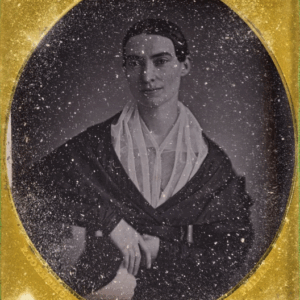JTF (just the facts): A total of 16 photographic works, framed in white and unmatted, and hung against white walls in a single room gallery space. (Installation shots below.)
The following works are included in the show:
- 3 archival pigment print collages, 2022, each sized roughly 24×29 inches, unique
- 13 archival pigment prints, 2022, sized 24×28, 24×36 inches, in editions of 3+2AP
- 1 artist’s book (no information provided)
- 3 resin sculptures, 2023, sized roughly 55x25x25, in editions of 3+2AP (shown in outdoor courtyard)
Comments/Context: While artistic collaborations have become commonplace in the fashion and music industries, in the world of fine art, and in particular photography, such pairings are far less common. Perhaps this is a result of the way brands (and marketing) have permeated some artistic disciplines, leading to collaborations that leverage and build on adjacent customer sets, while in others, the creation process is thought to be more singular and controlled, where the influence of one artist on another would be counter-productive rather than energizing or amplifying. Andy Warhol and Jean-Michel Basquiat tried out some cooperative art making in the mid 1980s – and they were both certainly aware of how fame and brands were part of their work – but we’ve never really seen such efforts take off more broadly.
As potential photographic matches go, the combination of Polly Borland and Penny Slinger is an altogether promising one. Both women have long focused their artistic attention on the female form, alternately using models and their own bodies as the foundation for incisive (and often defiantly provocative) studies of feminine roles, personas, bodies, and standards of beauty. Now both based in Los Angeles, this “PlayPen” project finds them working together to create various scenarios and setups, with Slinger behind the camera and Borland as the model/performer. With the power of the female gaze effectively doubled in these works, the two seem to have encouraged each other to push further, testing the limits of playfully irreverent messiness and the intentionally grotesque.
With examples from at least half a dozen sub-projects on view in this small show, it’s clear that Borland and Slinger have been freely experimenting with lots of different ideas, each an alternate way to surreally disrupt, modify, or reinterpret the female form. Several works make use of morph suits and nylons to sculpt, contain, and anonymize Borland’s body, with arms and breasts pulled tight like a fetish idol in one image, and Borland’s bent form seemingly augmented with additional cloth parts (as in the work of Mari Katayama) to turn her into a squiggling worm of fleshy segments in another. Two other photographs add bulbous fruits (like lemons, oranges, and bunches of grapes) underneath the stretchy suits, abnormally deforming the shapes and outlines of Borland’s body like diseased boils or protrusions. Each setup seems exaggerated to freakish extreme, where beauty and monstrosity get strangely intermingled.
Some of these efforts edge toward a wise-cracking kind of bizarre visual humor. Slinger and Borland channel the transgressions of Paul McCarthy in one work where Borland is covered by dirty clay, her breasts held like displays and her nose built up into a swelling crackled lump. In another image, they use a glass interruptor like Jenny Saville did, covering it with streaky swirled paint and smashing Borland’s open mouth against the glass. These bold incitements are then balanced by works where Borland’s body is covered with wet cloth, the tactile drapery seeming to mute the ecstasy and torment of her poses.
Still other images dig deeper into intentionally expressive distortion, using a range of techniques to push the photographs further from reality. A pair of works use mylar to create tweaked reflections, doublings, and light flares, with Borland’s messy red lipstick giving the works even more surreal drama; the bends and twists of the bodies are a bit reminiscent of André Kertész’ nude distortions, but refracted through a taunting female gaze that gives Borland’s body even more bulges. And a third image introduces movement, multiple/long exposure, and squiggled light, turning Borland’s body into a sparkling approximation that refuses to coalesce.
With all of these looks now neatly tucked into a visual archive, Slinger and Borland have gone on to remix them into new combinations, almost in the manner of paper dolls. Several of the “Exquisite Corpse” collages slice the original source photographs into three or six sections, and then reassemble hybrid bodies from various mismatched component parts. This unnatural doll motif connects then works back to the surreal images of Hans Bellmer, who reshuffled the forms of the female body into something more primal, like a process of metamorphosis.
Slinger and Borland seem to have fully enjoyed pushing seduction toward the edge of disgust in these pictures, not with the same sense of eroticism as artists like Hester Scheurwater, but still clearly having fun actively tweaking a range of established stereotypes and expectations. It is this uneasy balance of attraction and repulsion that gives these new works some of their tension, and the high-spirited friskiness of the setups makes even the most farcical of their constructions feel archly pointed. As photographic collaborations go, the Slinger/Borland duo seems like a workable model of paired artistic interplay, where overlapping worldviews encourage both artists to reach further together.
Collector’s POV: The works in this show are priced as follows. The individual photographs (regardless of size) are priced at $6800 each, while the collaged works are $10000 each. Borland’s work has little secondary market history, so gallery retail likely remains the best option for those collectors interested in following up. Slinger’s work, particularly her early feminist images from the 1970s, is similarly difficult to find at auction.
















